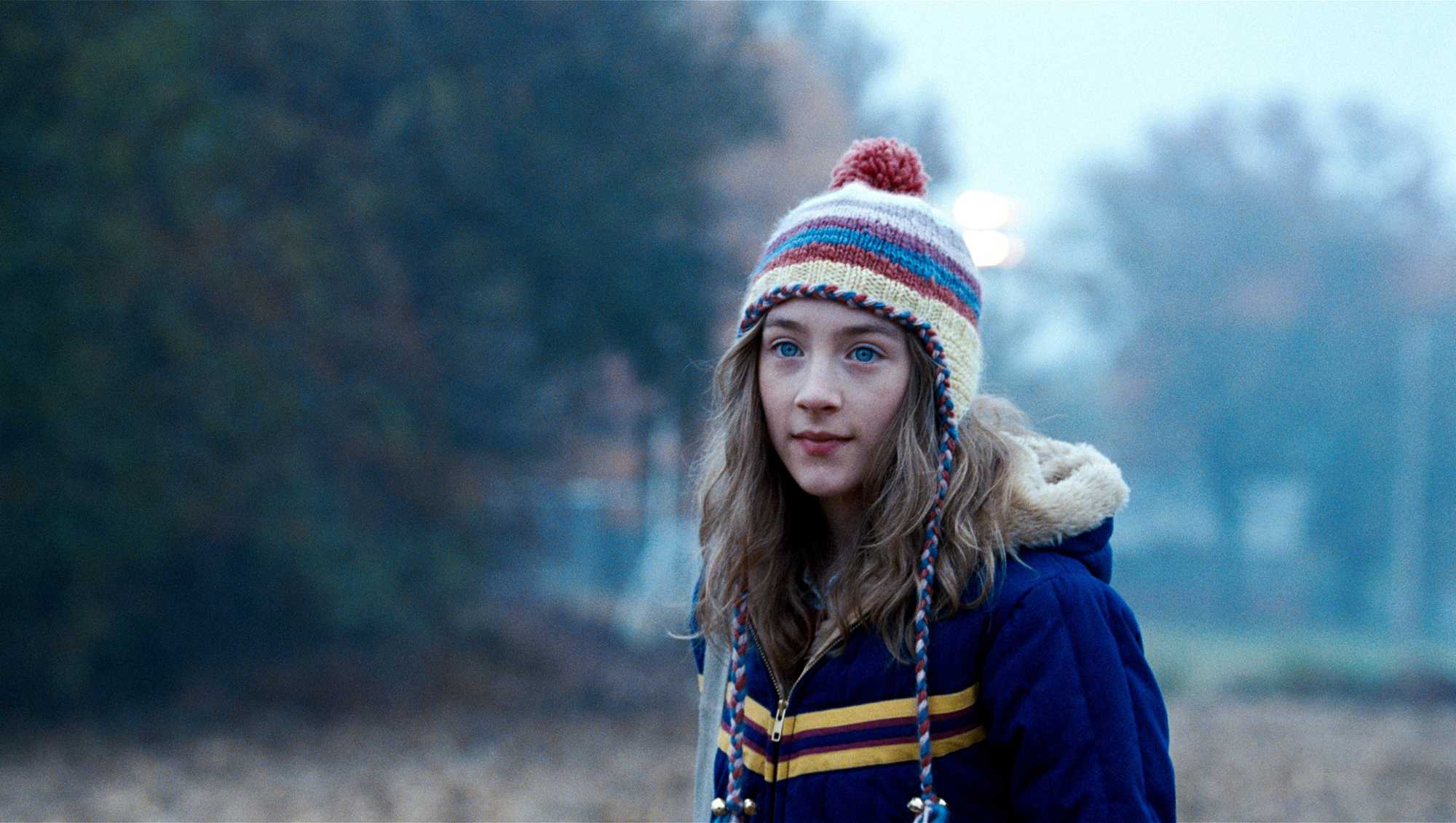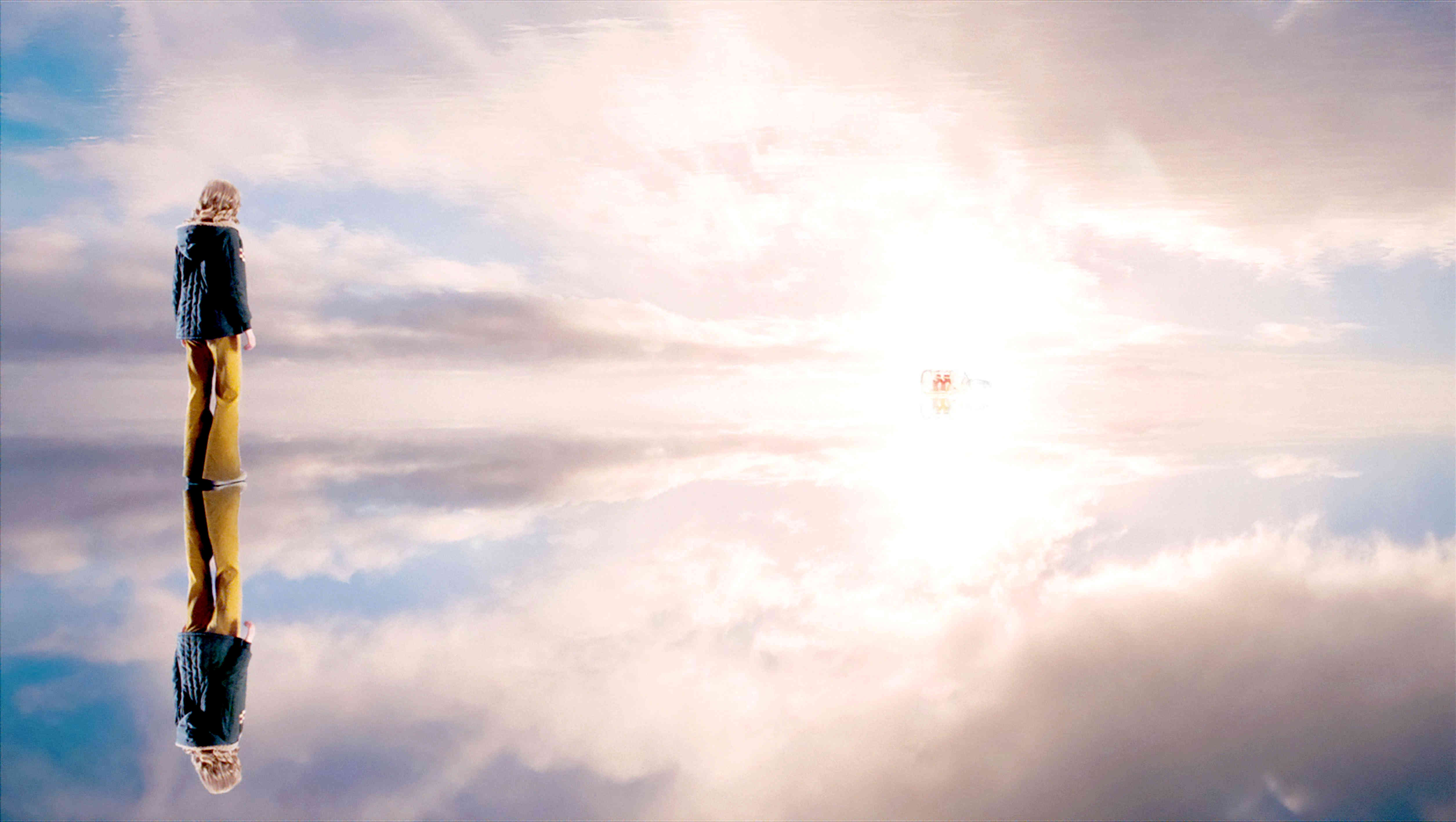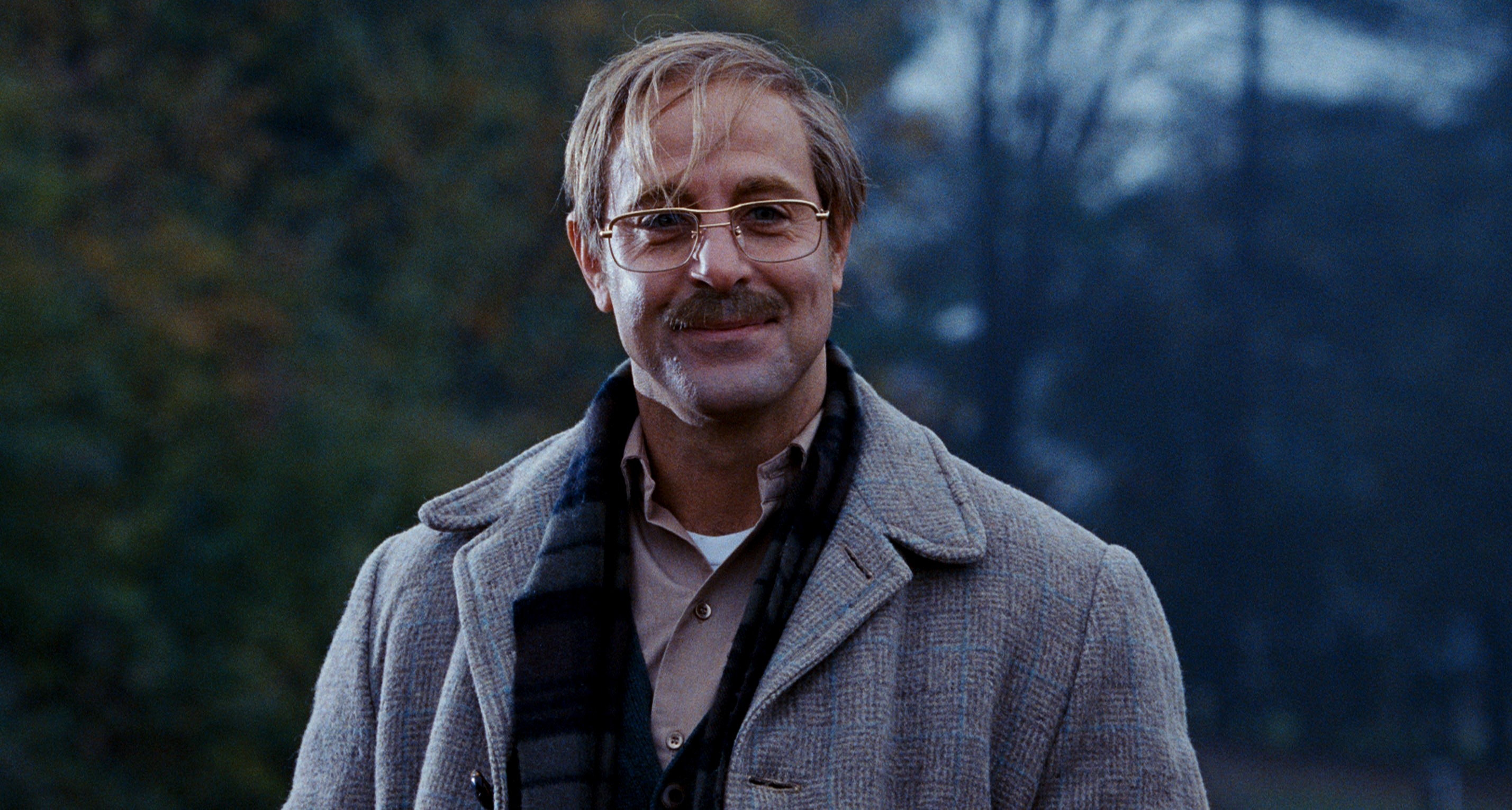Crew
Director – Peter Jackson, Screenplay – Philippa Boyens, Peter Jackson & Fran Walsh, Based on the Novel by Alice Sebold, Producers – Carolynne Cunningham, Peter Jackson, Aimee Peyronnet & Fran Walsh, Photography – Andrew Lesnie, Music – Brian Eno, Senior Visual Effects Supervisor – Joe Letteri, Visual Effects Supervisor – Christian Rivers, Visual Effects – Weta Digital, Special Effects Supervisors – Conrad F. Brink & Phil McLaren, Production Design – Naomi Shoban. Production Company – Wingnut Films/Paramount/DreamWorks SKG/Film 4.
Cast
Saoirse Ronan (Susie Salmon), Mark Wahlberg (Jack Salmon), Stanley Tucci (George Harvey), Rachel Weisz (Abigail Salmon), Rose McIver (Lindsey Salmon), Michael Imperioli (Detective Len Fenerman), Susan Sarandon (Grandma Lynn), Reece Ritchie (Ray Singh), Carolyn Dando (Ruth Connors), Nikki Soohoo (Holly Golightly), Amanda Michalka (Clarissa), Jake Abel (Brian Nelson), Christian Thomas Ashdale (Buckley Salmon)
Plot
From the afterlife, Susie Salmon tells the story of how she was murdered. In December 1973, she was an average fourteen-year-old schoolgirl in Norristown, Pennsylvania. One evening, neighbour George Harvey lured her to a dugout he had constructed in the middle of a field. Harvey was a paedophile who proceeded to attack and kill her. Susie came around in the afterlife but refused to go onto Heaven and preferred to stay and watch life back down on Earth. As she watches, her father becomes obsessed with trying to find her killer, but his obsession starts to tear the family apart. At the same time, Susie can see that Harvey has developed an interest in her sister Lindsey and is making plans to trap her too.
There was a time during the mid-00s that Peter Jackson was the unparalleled king of the world. He was the New Zealand wunderkind who had come from almost nowhere to take on one of the biggest film projects in history in making a film of J.R.R. Tolkien’s The Lord of the Rings trilogy – The Lord of the Rings: The Fellowship of the Ring (2001), The Lord of the Rings: The Two Towers (2002), The Lord of the Rings: The Return of the King (2003) – and moreover did it on his own rather than Hollywood’s terms. The Lord of the Rings films enjoyed a massive success at the box-office, culminating in The Return of the King sweeping the Academy Awards and Jackson topping the Number 1 spot on Premiere magazine’s Hollywood power list.
Subsequent to Lord of the Rings, Jackson’s films have never matched that same stellar success. Aside from the sleeper success of the Jackson-produced District 9 (2009) that came out four months before The Lovely Bones, Jackson’s other films have disappointed the expectations placed on their shoulders. Immediately after Lord of the Rings, Jackson conducted his long planned remake of King Kong (2005). This was a stunning piece of filmmaking that showed Jackson at the absolute peak of his game but also proved to be a relative box-office disappointment, earning far less than was originally anticipated and being divided in terms of critical reception. The Jackson produced Mortal Engines (2018) was a massive box-office flop.
Similarly, The Lovely Bones met an extremely mixed response so much so that it was withdrawn from its originally planned big Christmas 2009 US release and bumped off to January 2010, the usual time of the year when studios dump films they regard as not having high prospects either for Christmas box-office or end of year awards season cut-off. The Lovely Bones was at one point touted as a potential awards favourite but ended up being overlooked everywhere apart from a single Golden Globe and Academy Award nomination for Stanley Tucci. After its initial unsuccessful test run, the studio awkwardly attempted to remarket the film as something pitched to teenage girls. Certainly, the same crowd that breathlessly idolised The Lord of the Rings failed to turn out for The Lovely Bones – the audience I saw it with seemed substantially made up of people in their fifties.

Jackson adapts The Lovely Bones (2002), a novel by American writer Alice Sebold. The Lovely Bones was Sebold’s second book. Her first book Lucky (1999) was a non-fiction account of how she was raped as a university student and came forward to the police, ultimately resulting in her attacker’s conviction. The Lovely Bones proved a reasonable best-seller on bookshelves and the rights were snapped up, originally as a project for Scottish director Lynne Ramsey, best-known for indie works like Ratcatcher (1999), Morvern Callar (2002) and the subsequent We Need to Talk About Kevin (2011). This version ended up collapsing due to the shutting down of the Film 4 production company, whereupon DreamWorks SKG picked up the rights and Peter Jackson came aboard.
Certainly, The Lovely Bones came with an enormous advance buzz. I sat down to watch it expecting that Peter Jackson would pull off something amazing. I walked out with a massive sense of disappointment on the order of when, after decades of anticipation, George Lucas turned out the hugely underwhelming Star Wars Episode I: The Phantom Menace (1999) and Indiana Jones and the Kingdom of the Crystal Skull (2008).
The Lovely Bones emerges as a conceptual mix of The Dead Girl (2006), which charts the effects of the death of a girl on the other people connected to her life, combined with the visuals of What Dreams May Come (1998), a far more satisfying afterlife film from fellow New Zealander Vincent Ward where Ward used CGI effects to create an afterlife world of impossible imaginary landscapes conjured out of the dead person’s imagination. On a storytelling level, The Lovely Bones emerges as a variation on Ghost (1990) or perhaps The Invisible (2007), in which the protagonist is murdered near the start of the story and looks helplessly on from the afterlife and tries to affect the living to solve their murder. The Lovely Bones is also Peter Jackson returning to the Chick Flick territory of his earlier Heavenly Creatures (1994). Like Heavenly Creatures, Jackson tells a period crime story from a teenage girl’s point-of-view where he alternates the mundane reality with allegorical landscapes that sweep off into a world of the imagination.
The great disappointment about The Lovely Bones is that Peter Jackson is simply the wrong director for the material. The book is a tragedy about how a girl is murdered by a paedophile and looks on from the afterlife, observing the heart-rending effect the death has on her family. Contrarily, Peter Jackson has mounted The Lovely Bones partly as a murder mystery, but mostly as a visual effects vehicle. In the book, Alice Sebold did almost nothing to describe the realm that Susie had ended up in – it was deliberately vague and unstated. On screen, this becomes the leaping-off point for Jackson to jump off into What Dreams May Come territory with imaginary landscapes of fold-up mountains, crashing giant model ships, reflective lake surfaces, magically morphing seasonal changes, even hot-air balloons made of grass and miniature worlds floating in mid-air. It is the same approach that brought down Heavenly Creatures – in both cases, the material Jackson has in his hands are stories that should be told in concrete realist terms with the emphasis on the nuance of emotion, not stories that need to be conflated into visual effects vehicles.

Peter Jackson excels at one type of film – the epic CGI-driven fantasy – The Lord of the Rings, King Kong. He also does extremely well at the hilariously scatological – see the likes of Bad Taste (1988), Meet the Feebles (1990) and Braindead/Deadalive (1992). On the other hand, Jackson’s characters lack emotional depth. While Peter Jackson does some things extremely well – creating epic-sized battles, turning splatter and gore into an art form in Bad Taste and Braindead – emotional subtlety and drawing complexities of character out of his actors is not his forte. His characters often seem written in broad strokes of caricature. These things were masked somewhat in The Lord of the Rings and King Kong because they were larger-than-life films that were suited to heroic caricatures or else the respective actors provided the depth he did not. It was still noticeable at times – rather than showing Bilbo possessed by greed in The Fellowship of the Ring, Jackson inserted pop-up CGI effects; rather than show the emotion between Aragorn and Arwen in The Two Towers, Jackson threw in CGI dissolves. These betray either an inability to know how to create genuine emotional nuance or a lack of his trust in his actors to convey such.
It is telling that some of the more resonant character aspects of Alice Sebold’s novel – like where Susie delves down into Harvey’s childhood and understands how he became who he is and in so doing learns to forgive him, or the scenes where the dissatisfied wife decides to leave home – have ended up on the cutting room floor in favour of special effects. It seems indicative of the miscalculatedness of the exercise that a book about the rape and murder of a young girl is turned into a special effects film that now does not depict either, let alone even mention the term rape, so as to preserve the all-important US PG-13 certificate.
Indeed, the most heartfelt part of The Lovely Bones is when Mark Wahlberg lectures Saoirse Ronan on the art of model-making and how sometimes you just bear with something until you get it right. It could be Jackson the teenage model-maker and stop-motion animator speaking direct to the audience. (You can spot Jackson in a cameo as a man holding a Bolex camera in the background when the family visit the mall). It seems sad when you have a film about the murder of a young girl and the most passionate scenes in it seem to be a man talking about building model ships. It is a critical case of a filmmaker failing to realise his own limitations and weaknesses and taking on a project where his strengths are not suited.
The Lovely Bones often feels as though Peter Jackson is no more than a fifteen-year-old novice who has suddenly discovered symbolism for the first time and is determined to whack each member of the audience over the head with a very large mallet until they understand each point he is trying to make. Jackson seemed to discover the symbolic possibility of editing about the time of The Return of the King and the scene where Denethor’s eating of fruit at a banquet table was intercut with a massacre on the battlefield.
At times, The Lovely Bones feels like it is all crashingly over-inflated intercut symbolism – between Stanley Tucci constructing his lair and Mark Wahlberg making his model boats; between doctors tapping Wahlberg’s broken bones and the pagoda in the afterlife collapsing; or where Mark Wahlberg smashes up his model boats in grief and giant-sized model boats crash on the shore in Saoirse Ronan’s afterlife. Jackson pumps every dramatic action up with slow-motion emphasis – the scene at the end where Stanley Tucci throws the safe containing Susie’s bones into the pit is dragged out with so much slow-motion movement and symbolic intercut that it seems to go on for ten minutes.
Jackson has also discovered the lazy shortcut of using popular songs as signpost to the mood of a scene and populates the film with various dreampop artists – This Mortal Coil, Cocteau Twins – or more crudely plays T-Rex’s Get It On as Susan Sarandon takes over the house. It is something that makes The Lovely Bones reek of pretensions to self-importance, a film made by someone who does not realise the audience is a good deal smarter than he perceives them to be.
Even Jackson’s camerawork – where the camera sinuously glides up to place something or someone in the centre of the frame with ominous or emotively underlined import – drives you mad in its constant need to dramatically over-emphasise everything. One of the worst scenes is where Rose McIver breaks into Stanley Tucci’s house. An Alfred Hitchcock would have had you on the edge of the seat during the scene but instead Jackson lets the scene play out in deadeningly obvious places – that Stanley Tucci is going to come home in the midst of this; that he is going to go down into the cellar and maybe or maybe not see the broken glass; that he will think he hears something then shrug and decide he has not; that the board is going to creak and give her away. Jackson’s attempts to draw the scene out as suspense are woefully simplistic and predictable. If The Lovely Bones were a mid-range film coming from a neophyte director it would be excusable, but coming from a director who a couple of years ago headed the Hollywood power list, it seems unforgivably ham-fisted.

Even aside from that, The Lovely Bones fails to work as a story. Jackson strangely fails to do much to let us feel tragedy for Saoirse Ronan’s death or what her family are going through. He does become involved in the thriller side of it, although this is the unusual case of a thriller where we know who the killer is from the outset. Rather than a whodunnit or even a whydunnit, Jackson endeavours to create suspense around whether the family will manage to unite the clues together and look in Stanley Tucci’s direction. It is a thriller about corporeal catch-up, if you like.
The great disappointment about this is that Jackson, having opted to play everything as a thriller, never allows it to pay off. Though she holds the diary that could incriminate Stanley Tucci, Rose McIver inexplicably chooses not to give it to her grandmother. Stanley Tucci dumps the safe containing Susie’s lovely bones into the pit and leaves town. Up in the afterlife, Saoirse Ronan then philosophises about what her life meant. In an extraordinarily lame coda, we see Stanley Tucci approaching a girl in a parking lot and then a magical glow causing an icicle on a branch above to fall and hit his head, knocking him over the bank to his death. It is one of the groan-worthy divine retribution endings they use to insert into films like The Bad Seed (1956) because Hollywood morality codes insisted that bad people had to get their comeuppance. It is surely one of the least satisfying payoffs that one has seen in a film in some time.
Jackson has an impressive cast to hand, all of whom have turned out solid acting elsewhere. Here they only seem to inhabit their parts and no more than that. The worst piece of miscasting is Stanley Tucci. Hidden behind a thinning blonde cowlick and a pair of big glasses, Tucci is exactly what you would imagine the cartoon caricature of a creepy paedophile to be. For some reason, Tucci seems to play the part in a funny accent as though he had a mouth full of marbles, which proves highly distracting and completely unconvincing. (I remain completely baffled how Tucci managed to end up nominated for an Academy Award for such a silly performance). This is a film that would have worked no end better if Jackson and Tucci hadn’t strained at the sinister stalker cliche and had gone out and studied interviews with real-life paedophiles and incorporated some of the far creepier behaviours.
Saoirse Ronan, the great and talented find in films like Atonement (2007) and City of Ember (2008), gives an intelligent performance, even if the film restricts her to only sitting by in the afterlife and watching on without interacting. The one who aces the show is Susan Sarandon who has the most fun she has had on screen in some time as the grandmother.
The film does some things very well. The special effects are expectedly good, if lacking in any of the awe-inspiring dramatic flourishes of The Lord of the Rings and King Kong. One of the things that several Jackson films have shown is a love of 20th Century period kitsch – in particular, the affectionate recreation of the banality of 1950s suburbia that we see in both Braindead and Heavenly Creatures. Here Jackson and his art director have a field day and go to town stocking the house and malls with period dressings, clothing, even magazines in the bookstores.
After the uneven reception granted The Lovely Bones, Peter Jackson retreated to the safety of Middle-Earth with The Hobbit: An Unexpected Journey (2012), The Hobbit: The Desolation of Smaug (2013) and The Hobbit: The Battle of the Five Armies (2014). Jackson has also produced The Adventures of Tintin (2011), written/produced Mortal Engines (2018) and produced The Lord of the Rings: The War of the Rohirrim (2024).
Trailer here


